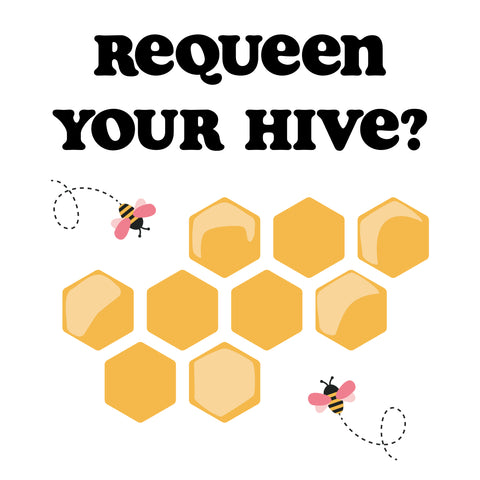HOW TO TELL IF YOUR HIVE IS QUEENLESS OR NEEDS TO BE REQUEENED
By Blake Shook
There are a variety of ways to tell if your hive is queenless or has lost its queen. At some point, all hives do eventually lose their queen and have to be requeened. At times they requeen themselves and we never know it (which isn’t ideal). Sometimes we catch it in time to do something about it. Or they fail at raising a new queen altogether, leaving them queenless. Either way, knowing what to look for is essential.
How to Tell if a Hive Is Queenless
- If there is no capped brood, eggs, larvae, or queen cells and it is between February and October, your hive is almost certainly queenless. I highly recommend reading “Spotting Eggs & Larvae.” It can often be very difficult to see eggs or larvae, even if they are present! If there is truly no brood in your hive, see “My Hive Has No Eggs, Larvae, Capped Brood, or Laying Queen” to determine what to do next, as it is a more complex issue.
- There is capped worker or drone brood but no eggs or larvae. In general, the points from number one apply here too. Make sure you aren’t missing eggs or larvae.
- There are no eggs or larvae, and there are queen cells with developing larvae present in the hive. If this is the case, see “Swarm Cells vs. Supersedure Cells” to determine what kind of queen cells they are. If they are swarm cells, see “3 Options for Preventing Swarms" or “Post-Swarm Care” depending on whether they have swarmed or not. If they are supersedure cells, see “My Hive Has Queen Cells & A Laying Queen, Now What?”
- There is brood but it’s all drone brood, with no worker brood present. See “Drone Layer.”
- Bees act nervous, jittery, and exhibit an unusually loud “roaring sound.”
Here is a great video by Dr. Jamie Ellis describing how to prevent swarms
How to Tell When a Hive Needs to Be Requeened
There can be many signs that you need to requeen a hive and many reasons to do so. In general, it’s a good idea to proactively requeen each hive every year before they begin to show signs of needing to be requeened. Benefits of a young queen can be a more robust population due to increased egg laying. It’s important to note that what may look like a failing queen is often the result of other factors. Below are the conditions you’ll see when a hive actually needs to be requeened:
- Your hive is consistently aggressive. If multiple bees are following you after inspections for several minutes, even as you walk away, and they behave this way consistently, it’s a good idea to requeen for your own comfort’s sake.
- The brood pattern is “spotty” throughout the hive. Many things other than a failing queen can cause a spotty brood pattern, so be sure to rule those out first. See “What Causes a Spotty Brood Pattern.”
- Dwindling, or a population that’s not growing when it should be. Between February and July, a hive’s population should be ever increasing. If a hive has been consistently well fed and doesn’t have a mite issue or a brood disease yet has not been growing or is dwindling for a few months, you should requeen.
- Drone brood is mixed in with the worker brood. A queen running out of sperm will result in unfertilized drone brood being mixed with worker bee brood. This will cause random large bumpy cells of capped drone brood mixed with the more even and flat worker brood. This will be visible throughout the hive, and you should see hundreds of these larger cells mixed with worker cells. Drone brood isolated on certain parts of frames is normal and expected rather than scattered throughout the worker brood.
- There are no eggs, larvae, or brood. This is a really tricky one! Depending on the stage of queenlessness, the hive may have already begun raising a new queen.
If your hive exhibits any one of the above five symptoms, it’s a good idea to go ahead and requeen as quickly as possible. See “How to Find a Queen and Requeen in 1 Visit.”
Let's look at this hive and see if it needs to be requeened!
By way of quick reminder, other causes of spotty brood can be:
- A mite infestation (make sure your mites are under 2 per 100 bees)
- A brood disease causing some brood to die (does uncapped larvae look pearly white and normal? If not, check out European Foulbrood.)
- Time of year: brood patterns tend to be more spotty over the summer months
- Pollen or nectar stored within the brood nest instead of around the brood nest
- If the brood is spotty only on some frames, the queen may be laying around cells of honey and pollen, creating a “spotty” appearance. Keep in mind that a failing queen does typically have a spotty brood pattern. However, it should be on all the frames throughout the hive.
If the above factors are not applicable and the brood is spotty, especially if it has been a year since you’ve requeened, it is most likely time to requeen.


